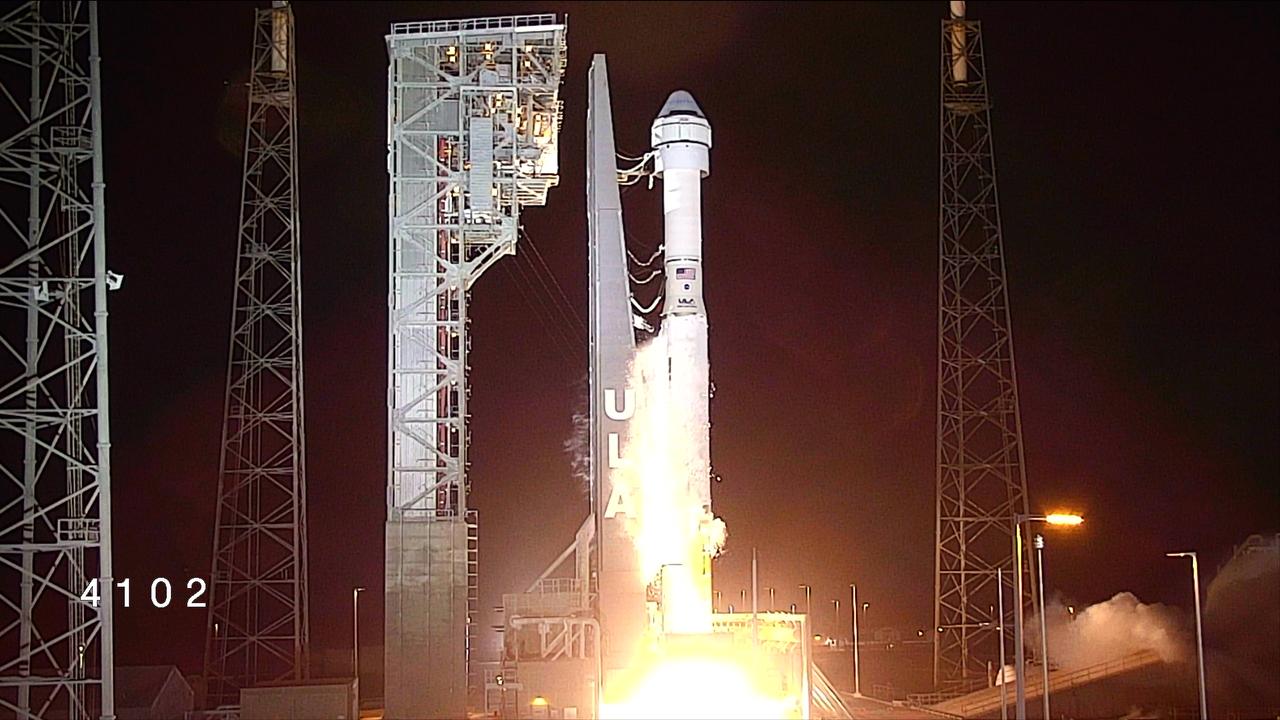
CAPE CANAVERAL—Boeing and NASA were working to preserve as many test objectives as possible for the unmanned orbital debut of Boeing’s CST-100 Starliner—including a parachute landing in White Sands, New Mexico—after a timer issue scuttled the capsule’s engine firing needed to reach the International Space Station (ISS).
“The spacecraft was not on the timer we expected her to be on,” Jim Chilton, senior vice president of Boeing’s Space and Launch division, told reporters during a post-launch news conference. “We don’t know if it started that way. We don’t know if something happened to cause it to be that way.”
The problem surfaced 31 min. after Starliner lifted off at 6:36 a.m. EST Dec. 20 atop a United Launch Alliance (ULA) Atlas V rocket from Cape Canaveral AFS. Instead of conducting a 40-sec. engine burn to set itself on a trajectory to rendezvous with the ISS, the capsule, believing the burn was already complete, was instead firing thrusters to maintain precise positioning.
Boeing flight controllers tried to manually order the burn, but it appears that Starliner was in a communications gap between two of NASA’s Tracking and Data Relay Satellites. Due to dwindling fuel supplies, managers decided to forego a possible ISS docking and instead set up a series of burns to raise the capsule’s orbit and preserve the option to land at White Sands Missile Range in New Mexico on Dec. 22.
NASA and Boeing also were mulling conducting simulated ISS approach maneuvers, as well as far-field sensor locks and other tests.
NASA Administrator Jim Bridenstine left open the possibility that Boeing could be cleared to conduct its second flight test with astronauts aboard, even though the automated docking system test was to take place at the ISS on Dec. 21 will not happen.
“I’m not saying we’re going to do it, but I’m not ruling it out either,” Bridenstine said. “This anomaly has to do with automation and [astronauts] are trained, specifically, to deal with the situation that happened today, when the automation was not working as planned. If we would have had crew in there, they would have been safe and … in fact, we may very well be docking with the ISS tomorrow.”
“We could have given the flight control team more options,” added NASA astronaut Mike Fincke, who is scheduled to fly on the Starliner crewed flight test.
Boeing was on the brink of becoming just the third U.S. company to reach the ISS. SpaceX, with a demonstration mission of its cargo Dragon capsule, was first in May 2012. Northrop Grumman, which inherited the Cygnus cargo line in its acquisition of Orbital ATK, was second in September 2013.
In addition to ongoing ISS resupply runs by SpaceX and Northrop, NASA in 2014 selected SpaceX and Boeing to develop crew transportation systems, a capability the U.S. has been without since the space shuttles were retired in 2011. The goal was to transition off Russian Soyuz transports, currently the only vehicles capable of ferrying crews to the ISS, by December 2017.
Starliner’s orbital debut was to set the stage for a weeklong mission at the ISS to test the vehicle’s autonomous rendezvous and docking systems, as well as its environmental control and landing systems. If the rendezvous had been successful, Fincke, NASA astronaut Nicole Mann and Boeing’s Chris Ferguson were expected to launch on a second Starliner test to the ISS early next year.
SpaceX, which completed a similar uncrewed dress rehearsal of its Dragon capsule in March, is likewise positioned to fly NASA astronauts Bob Behnken and Doug Hurley on a crewed flight test in early 2020.
Starliner’s docking at ISS, which had been scheduled for 8:27 a.m. EST Dec. 21, would have been a poignant moment for Boeing, which has been NASA’s prime contractor for the station since 1993.
In contrast to the company’s cost-plus-award fee agreement for the ISS, Boeing, along with SpaceX, is developing and selling crew flight services under fixed-price contracts, currently worth $4.33 billion and $2.61 billion, respectively. The agreements cover two flight tests to the ISS and up to six operational missions per company.
NASA added $287.2 million to Boeing’s original award to advance production of hardware for future missions, a move criticized by NASA’s Office of Inspector General in a November 2019 report.
The office determined that NASA is paying Boeing $90 million for a four-person Starliner crew rotation mission, compared to $55 million to fly four astronauts on a SpaceX Crew Dragon capsule.
When asked about the price difference, NASA Administrator Jim Bridenstine told reporters the companies did not start from the same place. “We spent billions of dollars helping SpaceX develop commercial [ISS] resupply, and after that was successful, Dragon was modified for human flight. The cost to modify from commercial resupply to commercial crew was not as much as what Boeing did, basically starting from scratch and trying to meet the same timeline for commercial human spaceflight,” he said.
Starliner’s orbital debut also put ULA, a partnership of Boeing and Lockheed Martin, one step closer to entering the human spaceflight business.
For the first time in its 81 flights, the rocket flew without a nosecone and with a dual-engine Centaur upper stage and other modifications to accommodate a crewed vehicle. The twin Aerojet Rocketdyne RL10A-4-2 engines will give future astronauts a smoother descent in case launch has to be aborted due to a failing booster.






Comments